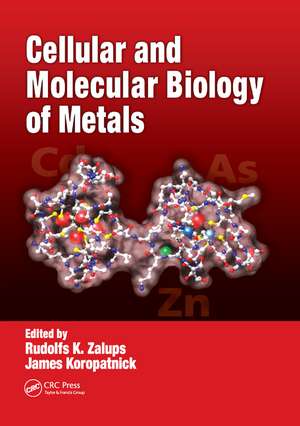Cellular and Molecular Biology of Metals
Autor Rudolfs K. Zalups, D. James Koropatnicken Limba Engleză Paperback – 10 sep 2018
This authoritative resource reviews the physiological mechanisms underlying the handling of essential and toxic metal ions, including metal ion homeostasis, metals and enzyme activity, metals and transcriptional regulation, and metal ion transport. It also analyzes other functions designed to avoid metal-induced toxicity and mediate the metal enhancement of cellular function.
The role of metal ions and their effect on mammalian cells and organs are only beginning to be truly defined. Cellular and Molecular Biology of Metals arms metals toxicologists and cellular and molecular biologists with the necessary knowledge they need to take the research effort to the next level.
Key selling features:
- Presents the most recent advances in the cell and molecular biology of metal ions
- Provides a complete exploration of transport mechanisms
- Addresses homeostatic metals as well as several environmentally relevant toxic divalent cations
- Features contributions from experts in their respective fields
Preț: 847.73 lei
Preț vechi: 1140.45 lei
-26% Nou
Puncte Express: 1272
Preț estimativ în valută:
162.22€ • 169.79$ • 135.01£
162.22€ • 169.79$ • 135.01£
Carte tipărită la comandă
Livrare economică 31 martie-14 aprilie
Preluare comenzi: 021 569.72.76
Specificații
ISBN-13: 9781138372658
ISBN-10: 113837265X
Pagini: 440
Ilustrații: 76
Dimensiuni: 178 x 254 mm
Greutate: 0.45 kg
Ediția:1
Editura: CRC Press
Colecția CRC Press
ISBN-10: 113837265X
Pagini: 440
Ilustrații: 76
Dimensiuni: 178 x 254 mm
Greutate: 0.45 kg
Ediția:1
Editura: CRC Press
Colecția CRC Press
Public țintă
ProfessionalCuprins
Cellular Inorganic Chemistry Concepts and Examples. Molecular and Cellular Biology of Mercury in the Kidneys. Essential and Toxic Metal Transport in the Liver. Molecular and Cell Biology of Lead. Transport and Biological Impact of Manganese. Metallothionein and Metal Homeostasis. Cellular and Molecular Biology of Iron-Binding Proteins. The Regulatory and Signaling Functions of Zinc Ions in Human Cellular Physiology. Glutathione, Protein Thiols, and Metal Homeostasis. Ionic and Molecular Mimicry and the Transport of Metals. Heavy Metal Transport and Detoxification in Crustacean Gastrointestinal and Renal Epithelial Cells. Metals and Cell Adhesion Molecules. Iron Metabolism and Disease. Metal Influences on Immune Function.
Notă biografică
Rudolfs K. Zalups, PhD, trained as a fellow and instructor at the Mayo Clinic, Yale University School of Medicine, University of Maryland School of Medicine, and the University of Rochester School of Medicine and Dentistry. He is now a professor at the Mercer University School of Medicine in Macon, Georgia.
James Koropatnick, PhD, is a Distinguished Oncology Scientist, Director of the LRCP Cancer Research Laboratory Program, Director of the UWO/CIHR Strategic Training Program in Cancer Research and Technology Transfer, Assistant Director of the Lawson Health Research Institute, and a Full Professor in the UWO Department of Oncology with cross-appointments in the UWO Departments of Microbiology and Immunology, Physiology and Pharmacology, and Pathology. He is also the Chief Scientific Officer of Sarissa, Inc. (a biotech discovery company) and sits on the Advisory Boards of Critical Outcomes Therapeutics, Inc., ID Laboratories, Inc., and MedVax Pharma, Inc.
James Koropatnick, PhD, is a Distinguished Oncology Scientist, Director of the LRCP Cancer Research Laboratory Program, Director of the UWO/CIHR Strategic Training Program in Cancer Research and Technology Transfer, Assistant Director of the Lawson Health Research Institute, and a Full Professor in the UWO Department of Oncology with cross-appointments in the UWO Departments of Microbiology and Immunology, Physiology and Pharmacology, and Pathology. He is also the Chief Scientific Officer of Sarissa, Inc. (a biotech discovery company) and sits on the Advisory Boards of Critical Outcomes Therapeutics, Inc., ID Laboratories, Inc., and MedVax Pharma, Inc.
Descriere
Highlighting significant advancements in the roles of certain metal ions in the conformational changes and function of cellular proteins, this volume discusses the mechanisms involved in the transport of metal ions into and out of target cells, particularly epithelial cells. It explains the role of key biologically relevant divalent metal ions involved in the molecular and cellular biology of various target cell populations. Although it primarily focuses on homeostatic metals such as nickel, zinc, and chromium, the text also discusses a few environmentally relevant toxic divalent cations, including mercury, cadmium, and arsenic.
